
For the given P-V graph of an ideal gas, chose the correct V-T graph. Process $1 \rightarrow 2$ is adiabatic. (Graphs are schematic and not to scale).
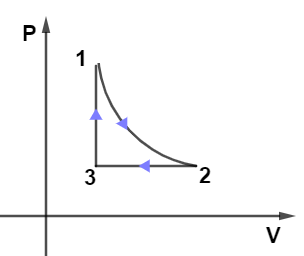
(A) 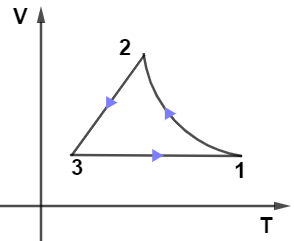
(B)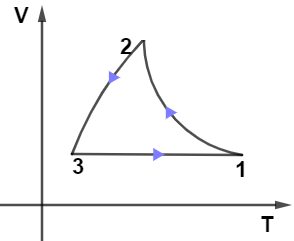
(C)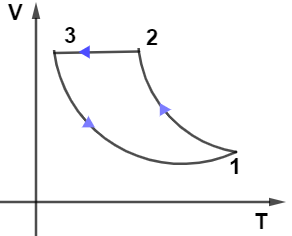
(D)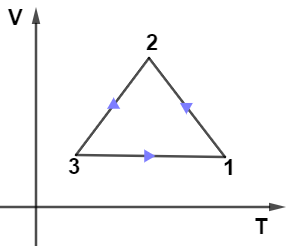
Answer
216.3k+ views
Hint: In order to solve this question, we will observe the each path of the given PV diagram cycle, and then using concepts of constant pressure, constant temperature, and constant volume and with an understanding of linear and non-linear graphs we will match the correct graph for the representation of VT diagram of same corresponding PV diagram.
Complete answer:
From the given PV diagram let us observe the path $2 \rightarrow 3$ which is kept at constant pressure as we know at constant pressure-volume is directly proportional to the temperature which means the graph for path $2 \rightarrow 3$ will be a straight line passing through the origin, so only graph in given options (B) and (D) have this condition.
Now, on observing the path $1 \rightarrow 3$ from the PV diagram we see that it’s kept at the constant volume it means in the VT diagram path $1 \rightarrow 3$ must be kept at a constant volume so from options only (B) and (D have this condition.
Now, the last path $1 \rightarrow 2$ in the PV diagram is adiabatic so in the VT diagram it can’t be a straight line it must a curve, only option (A) fulfills this condition.
Hence, option (A) is the correct answer.
Note: It should be remembered that when the volume is directly proportional to temperature the equation becomes $V = kT$ which is an equation of a straight line passing through origin and adiabatic processes have curved graph because of the equation $P{V^{\gamma} } = K$.
Complete answer:
From the given PV diagram let us observe the path $2 \rightarrow 3$ which is kept at constant pressure as we know at constant pressure-volume is directly proportional to the temperature which means the graph for path $2 \rightarrow 3$ will be a straight line passing through the origin, so only graph in given options (B) and (D) have this condition.
Now, on observing the path $1 \rightarrow 3$ from the PV diagram we see that it’s kept at the constant volume it means in the VT diagram path $1 \rightarrow 3$ must be kept at a constant volume so from options only (B) and (D have this condition.
Now, the last path $1 \rightarrow 2$ in the PV diagram is adiabatic so in the VT diagram it can’t be a straight line it must a curve, only option (A) fulfills this condition.
Hence, option (A) is the correct answer.
Note: It should be remembered that when the volume is directly proportional to temperature the equation becomes $V = kT$ which is an equation of a straight line passing through origin and adiabatic processes have curved graph because of the equation $P{V^{\gamma} } = K$.
Recently Updated Pages
JEE Atomic Structure and Chemical Bonding important Concepts and Tips

JEE Amino Acids and Peptides Important Concepts and Tips for Exam Preparation

Electricity and Magnetism Explained: Key Concepts & Applications

Chemical Properties of Hydrogen - Important Concepts for JEE Exam Preparation

JEE Energetics Important Concepts and Tips for Exam Preparation

JEE Isolation, Preparation and Properties of Non-metals Important Concepts and Tips for Exam Preparation

Trending doubts
JEE Main 2026: Application Form Open, Exam Dates, Syllabus, Eligibility & Question Papers

Derivation of Equation of Trajectory Explained for Students

Hybridisation in Chemistry – Concept, Types & Applications

Understanding the Angle of Deviation in a Prism

Understanding Collisions: Types and Examples for Students

How to Convert a Galvanometer into an Ammeter or Voltmeter

Other Pages
JEE Advanced Marks vs Ranks 2025: Understanding Category-wise Qualifying Marks and Previous Year Cut-offs

Units And Measurements Class 11 Physics Chapter 1 CBSE Notes - 2025-26

NCERT Solutions For Class 11 Physics Chapter 8 Mechanical Properties Of Solids

Motion in a Straight Line Class 11 Physics Chapter 2 CBSE Notes - 2025-26

NCERT Solutions for Class 11 Physics Chapter 7 Gravitation 2025-26

Ideal and Non-Ideal Solutions Explained for Class 12 Chemistry




